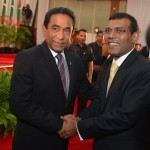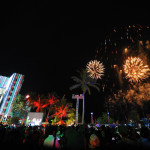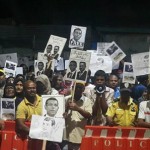In 1915 World War I was in full swing, but the people of the Maldives were continuing simple lives in relative peace and security.
But, the peace of Kudarikilu, a small island in Baa Atoll, was shattered when local fishermen found an unusual object floating in the sea.
Abu Bakuru Mohamed, a judge at Baa atoll Kendhoo, recalls the stories his old friend Mohamed Manik had told him about the incident.
“Mohamed Manik was alive in 1915, and he saw the events that unfolded on Kudarikilu,” recalls Abu Bakuru.
According to Manik, it was a clear Thursday and fishing vessels from Kudarikilu and Kendhoo were out on a nearby channel.
“The Kendhoo dhoni got a call from the Kudarikilu people, they said ‘we found something, come help us.'”
The round object with the “silver skin” was in fact a drifting contact mine. During World War I, many countries protected their shores by dumping a plethora of naval mines. These were cheap and deadly. Often, floating mines would break away from their moorings and drift with the currents: a disaster waiting to happen, as many of these mines could stay active for years.
Normally, foreign objects would have been taken to the atoll office, but since the weekend was Thursday and Friday and the atoll office was closed, the fishermen decided to tow it back to Kudarikilu.
The crew brought the mine ashore near the eastern side of the island, where all the vessels were moored. Rolling it onto the beach, they left it there.
The next morning, the people of Kudarikilu went about their usual routine and in the afternoon went to Friday prayers.
Manik recalled that in the afternoon, the people went down to move one of the dry docked dhonis back into the water.
In many Maldivian islands, people gather to witness and lend a hand in this process. While down at the beach people also gathered to investigate the strange metal device.
“A young man, started playing with the screws and prodded it with a stick,” says Abu Bakuru.
All of a sudden there was a massive commotion as the mine started to smoke, he said, and it then started spinning and partially dug itself into the sand.
People moved in closer to investigate when it exploded with an almighty bang, sending a massive shock wave through the island.
“There was a massive explosion, it was terrible, there was bits of body everywhere, skin was plastered onto the coconut palms, people even found fingers all the way across the other side of the island.”
Abu Bakkuru recalls people on Kendhoo telling him about the loud bang. Even the island of Kendhoo, which lies four miles off Kudarikilu, felt the explosion.
“People told me of a huge plume of smoke that followed the explosion,” recalls Abu Bakuru.
Over the years the story has had many different versions, while the death toll varies with every telling.
According to Manik, 60 people lost their lives in the incident. Naval mines from that period carried up to 80 kilograms of explosives, and were designed to rip the hulls off massive iron clad ships.
However, Kudarikilu Councilor Hassan Firaaj says according to reports only seven to nine people died.
Immediately after the explosion, fishermen from Kendhoo instantly knew it must have been something to do with the object they found on Thursday.
“That silver ball they found exploded, I am sure of it!” one of the Kendhoo fisherman immediately claimed.
After some deliberation, the islanders of Kendhoo sent a dhoni to investigate the scene.
Manik said that the explosion had caused the whole lagoon to turn into a slight yellow colour.
“It must have been the explosive chemicals inside the mine.”
The Kudarikilu people quickly sent a message to the atoll office who came and investigated.
Abu Bakuru said that since all dhonis were still running on sails, the news of the incident did not reach Male’ for quite some time.
Today, there is a harbour on the site of the mine explosion.
Abu Bakuru recalls, “Sixty years ago I visited the site, the crater was still there, just as if it had happened yesterday. It was massive.”
The people of Kudarikilu still tell the story of the unfortunate events of that Friday afternoon, passing it on from generation to generation.
Although drifting naval mines were banned after World War I, some countries continued to use them.





For those interested, there is a short story written by Maldivian writer Mohamed Waheed Madulu based on this incident. Titled, 'Silver Cylinder' it has been widely recognized both nationally and abroad.
really? i would like to read ‘Silver Cylinder’. where can i get it?
There is a book of short stories by Madulu Mohamed Waheed published by the National Centre for Historical and Linguistic Research. I think the title is 'Waheed's Short Stories' (Waheedhuge Kuru Vaahaka Thah). Check their book shop or ask some one at the center.
In fact some of the phrasing the Minivan News writer has used seem exactly similar to the phrasing in the story, like this paragraph: “There was a massive explosion, it was terrible, there was bits of body everywhere, skin was plastered onto the coconut palms, people even found fingers all the way across the other side of the island.”
thanks, hashim.
It seems that the Minivan Writer has copied the lines from that book. Also, Minivan News should source when using secondary materials.
Thank you for your concern regarding our editorial policies. The paragraph in question was a direct quotation obtained in a telephone conversation with Mr Abu Bakuru Mohamed. In addition, while we like to source as close as possible to the story, we would like to point out that our ability to obtain primary information concerning World War I is limited by human longevity.
It’s very rare to find historical articles like this. You have covered two very important stories recently. Those are excellent piece of research and hard work. Keep it up.
this is a cool article i like this
i am from KUDARIKILU, and the information that has been written in this article seems to be just like what i have heard so far,,, its a very historical disaster that happened in my island. loved reading it, thnx